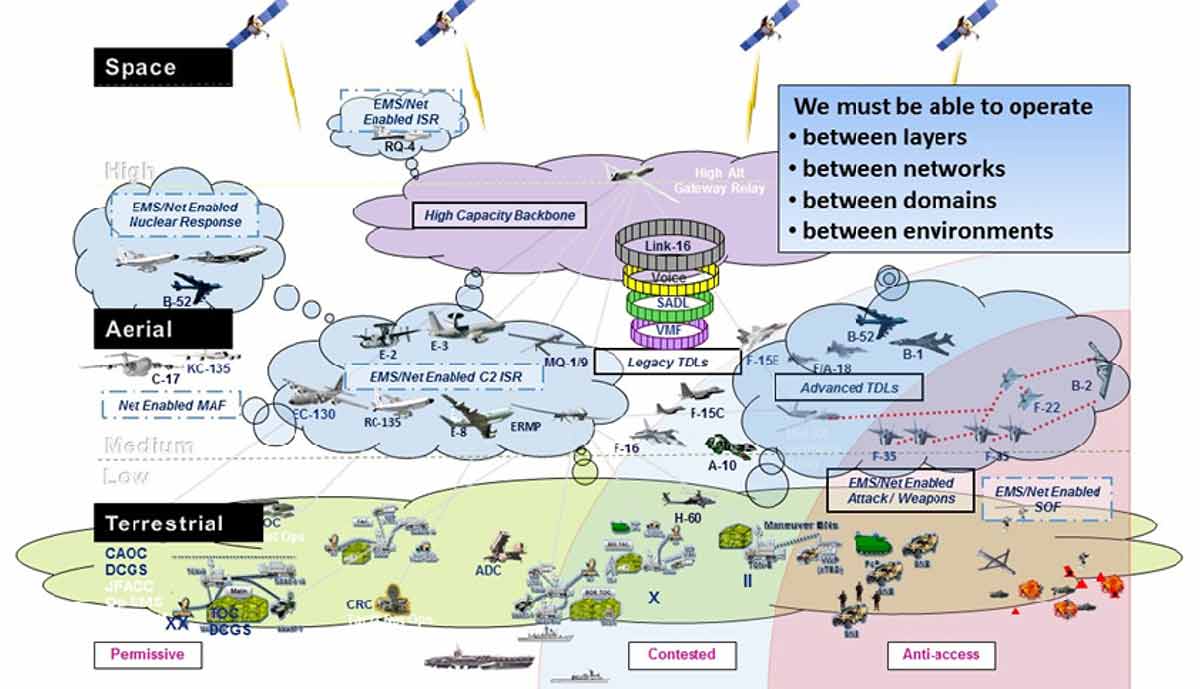Introduction
This article provides an introduction to DoD policy, guidance and the acquisition process. E3 is defined as the impact of the Electromagnetic Environment (EME) upon the operational capability of military forces, equipment, systems, and platforms. E3 encompasses all electromagnetic disciplines, including Electromagnetic Interference and Electromagnetic Compatibility (EMI/EMC); Electromagnetic Vulnerability (EMV); Electromagnetic Pulse (EMP); natural phenomena such as lightning, electrostatic discharge (ESD) and precipitation static; and Hazards of Electromagnetic Radiation to Personnel (HERP), Ordnance (HERO), and Fuel (HERF). In addition, Spectrum Supportability must be addressed in conjunction with E3 for Spectrum Dependent (S-D) systems.
INTRODUCTION TO DoD POLICY, GUIDANCE, & THE AQUISITION PROCESS
Early consideration of E3 and Spectrum Supportability (SS) in electronic and S-D systems is a fundamental criterion that must be satisfied before communications-electronics (CE) equipment and related weapons systems are developed and fielded. Development or acquisition of systems that meet operational requirements, but are not electromagnetically compatible or fail to obtain spectrum supportability, creates a potential for severe mutual interference between themselves and other spectrum users, squanders resources, and delays fielding warfighting capabilities to field units.
Equipment, subsystems and systems employed for military purposes are exposed to extreme EMEs. Providing the warfighter with systems that will operate within these extreme EMEs requires specific requirements, design and test considerations. This new mini guide from Interference Technology will review E3 related policies and requirements specific to military equipment, subsystems and systems, from a top down perspective, including overviews of MIL-STD-464C and MIL-STD-461G, a listing of relevant military E3 related documents and points of contact.
Real World Operational Impacts/Examples
There are many examples of EMC and spectrum supportability problems in military systems which have caused serious, and even catastrophic, operational and programmatic problems. Some examples include:
- Between 1981 and 1987, several UH-60 Blackhawk helicopters nose-dived and crashed, killing 22 servicemen. The crashes were attributed to insufficient flight control immunity to high intensity radiated fields when flying past radio broadcast towers. This interference produced uncommanded control surface movements causing fatal dives.
- The US Air Force has had to address a potential frequency-interference issue with their B-2 bombers. Analysis indicates a high probability of the Raytheon AN/APQ-181 radar system on the B-2As interfering with commercial satellite communications after 2007.
- The B-2’s radar would most likely disrupt their transmissions and could damage commercial communications satellites, for which the USAF likely would be liable, according to industry sources. The total estimated cost is expected to exceed $1.3B.

FIGURE 1: Spectrum Dominance Illustration
- An AV-8B Harrier was lost and the pilot killed as a result of the indirect effects of a lightning strike. The lightning strike caused large internal electrical currents inside the wing. A coupler inside the wing fuel tank system was not designed to withstand such a current flowing across it and sparked, causing a fuel explosion.
While there have been these and other catastrophic examples, the vast majority are simply performance degradation problems that put our fighting forces at risk, delay fielding of important capabilities or stretch budgets beyond their limits.
DoD Policy and Perspective
The need for control of the electromagnetic spectrum and the EME is understood at the highest levels of DoD management and military operational directors, who must ensure that U.S. Forces have the ability to operate effectively in all domains: space, sea, land, air, information; and can conduct operations with a combination of forces tailored to different situations. Military success relies on Information Superiority: Obtaining, processing, distributing, and protecting accurate information while exploiting or denying the adversary’s ability from doing the same. Much of the information superiority depends on access to the RF spectrum. The priority placed on force mobility, range, and speed dictates that much of the information technology be wireless. Again, the critical medium is the EM spectrum with EMI free operations.
Spectrum dominance is a cornerstone of the DoD’s war-fighting strategy. To maintain this spectrum dominance, the spectrum and system EMC within the spectrum must be carefully controlled.
While EMI (including interference caused by spectrum management problems) can cause catastrophic problems, the majority of interference problems render systems less than fully effective, which reduces operational readiness and increases costs. These may be hard to see, and more difficult to quantify in terms of return on investment; however, taking care of E3 and Spectrum Certification requirements early on in a program provides significant future cost savings. Figure 1 illustrates the concept of spectrum dominance.

FIGURE 2: E3 and SS Processes
Acquisition Process
The military procurement system is driven by high level policies that flow down to processes and procedures covering anything that is considered a technical requirement. E3 and SS are no different.
There are high level policies that require programs to consider E3 and SS in system design, procurement and fielding as well as policies requiring that military systems follow the rules of frequency use. The two most significant top level directives that require spectrum management and E3 control in the acquisition cycle are:
DoD Instruction 3222.03 DoD Electromagnetic Environmental Effects (E3) Program, 24 Aug 2014
This Instruction drives the requirement that “All electrical and electronic systems, subsystems, and equipment, including ordnance containing electrically initiated devices, shall be mutually compatible in their intended EME without causing or suffering unacceptable mission degradation due to E3.” It identifies many high level DoD organizations and outlines their responsibilities for E3 control within systems acquisition and operational communities.
DoD Instruction 4650.01, Policy and Procedures for Management and Use of the Electromagnetic Spectrum, 09 Jan 2009
This instruction outlines the requirements for DoD spectrum use to ensure that systems can operate without interference. Some requirements include:
Obtaining a written determination that there is reasonable assurance of Spectrum Supportability for DoD organizations developing or acquiring spectrum-dependent equipment.
Applicability of Spectrum Supportability determination requirements for “off-the-shelf” or other non-developmental systems (including commercial items).
The requirement to produce a Spectrum Supportability Risk Assessment (SSRA) to identify and assess an acquisition’s potential to affect the required performance of the newly acquired system or other existing systems within the operational EME. SSRAs identify SS and E3 risks and the steps that need to be taken to mitigate the risks.
The fundamental E3 and SS related processes and tasks over the military system procurement cycle are shown in Figure 2.
About the Authors
Tony Keys is the President and Principal Consultant for EMC Analytical Services. Mr. Keys has over 20 years of experience in Electromagnetic Environmental Effects (E3) engineering. His experience covers a wide range of E3 specialty areas from a multitude of organizational aspects including E3 support contracting, DoD E3 service, and DoD system development. He can be reached at tony.keys@emcanalyticalservices.com.
The author would like to thank Brian Farmer for his significant contribution to the article.
Brian Farmer has a long career providing E3 and Spectrum Supportability systems engineering and program management services to the DoD, including the Naval Air Systems Command (NAVAIR), the Joint Spectrum Center (JSC) and the Naval Surface Warfare Center Dahlgren Division. After working for several companies in the E3 engineering business, Brian formed EMC Management Concepts in 2002.
In addition to being CEO of EMC Management Concepts, Brian still provides direct E3 program management support to several Navy offices and the JSC. He leads contract efforts to develop and deliver E3 and Spectrum Supportability training to the acquisition community. He can be reached at bdfarmer@emcmanagement.com




